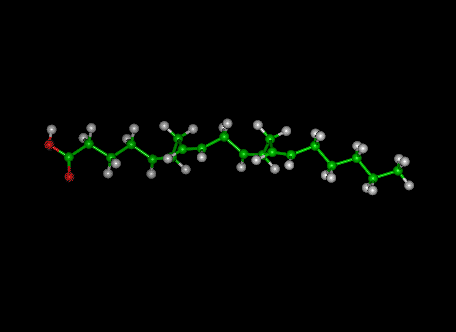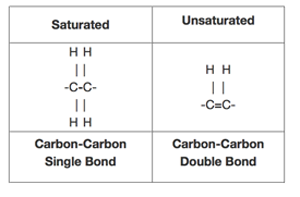What are omega-6 fatty acids?

What is the difference between saturated and unsaturated fatty acid?
All fats, including saturated fatty acids, have important roles in the body. In saturated fatty acids the carbon atoms are essentially saturated with hydrogen atoms. All the bonds are single bonds. In unsaturated fatty acids there are less hydrogen atoms attached the the carbon atoms, instead we see double bonds in some locations between carbon atoms. The number of double bonds and positions are critical to function. See types of fatty acids for more information.

Above: The structure of saturated and unsaturated chemical bonds looks like the diagram below.
What are Omega-6 Fatty Acids
Omega-6 fatty acids (also referred to as ω-6 fatty acids or n-6 fatty acids) are a family of polyunsaturated fatty acids that have in common a final carbon-carbon double bond in the n-6 position, that is, the sixth bond, counting from the methyl end. Examples of n-6 fatty acids are: linoleic and arachidonic acid.
Linoleic acid-C₁₈H₃₂O₂

Linoleic acid (18:2, n−6), the shortest-chained omega-6 fatty acid. Food sources high in linoleic acid and other omega 6-fatty acids include: seeds and nuts, safflower, sunflower, corn, soybean and sesame oil. You can also acquire omega-6 fatty acids from meat, poultry, seafood and eggs.
Members of the family can have pro-inflammatory effects because the end-product of n-6 PUFA metabolism, arachidonic acid, is a precursor for pro-inflammatory eicosanoids.
Arachidonic Acid -C20H32O2

The biological effects of the omega-6 fatty acids are largely produced during and after physical activity for the purpose of promoting growth and during the inflammatory cascade to halt cell damage and promote cell repair by their conversion to omega-6 eicosanoids that bind to diverse receptors found in every tissue of the body.
Omega-6 fatty acids are types of fats found in vegetable oils, including corn, evening primrose seed, safflower, and soybean oils. Other types of omega-6 fatty acids are found in black currant seed, borage seed, and evening primrose oils. Beef is also high in omega-6 fatty acids. However in grass fed beef the Omega-6 to Omega-3 Ratio is around 3:1 compared to store bought grain which is about 20:1. See: The importance of the ratio of omega-6/omega-3 essential fatty acids.
Omega-6 Fatty Acids and Health -- The Good and Bad..
Why are Omega-6 molecules are important?
Omega-6 fatty acids play a crucial role in brain function, and normal growth and development. Omega-6 fatty acids help stimulate skin and hair growth, maintain bone health, regulate metabolism, and maintain the reproductive system. Omega-6 fatty acids are precursors to endocannabinoids, lipoxins, and specific eicosanoids.
Omega-6 may Increase Obesity
"...Recent studies in humans show that in addition to absolute amounts of omega-6 and omega-3 fatty acid intake, the omega-6/omega-3 ratio plays an important role in increasing the development of obesity via both AA eicosanoid metabolites and hyperactivity of the cannabinoid system, which can be reversed with increased intake of eicosapentaenoic acid (EPA) and docosahexaenoic acid (DHA). A balanced omega-6/omega-3 ratio is important for health and in the prevention and management of obesity..." See An Increase in the Omega-6/Omega-3 Fatty Acid Ratio Increases the Risk for Obesity
Health Implications of High Dietary Omega-6 Polyunsaturated Fatty Acids-
"...Omega-6 (n-6) polyunsaturated fatty acids (PUFA) (e.g., arachidonic acid (AA)) and omega-3 (n-3) PUFA (e.g., eicosapentaenoic acid (EPA)) are precursors to potent lipid mediator signalling molecules, termed “eicosanoids,” which have important roles in the regulation of inflammation. In general, eicosanoids derived from n-6 PUFA are proinflammatory while eicosanoids derived from n-3 PUFA are anti-inflammatory. Dietary changes over the past few decades in the intake of n-6 and n-3 PUFA show striking increases in the (n-6) to (n-3) ratio (~15 : 1), which are associated with greater metabolism of the n-6 PUFA compared with n-3 PUFA. Coinciding with this increase in the ratio of (n-6) : (n-3) PUFA are increases in chronic inflammatory diseases such as nonalcoholic fatty liver disease (NAFLD), cardiovascular disease, obesity, inflammatory bowel disease (IBD), rheumatoid arthritis, and Alzheimer's disease (AD). By increasing the ratio of (n-3) : (n-6) PUFA in the Western diet, reductions may be achieved in the incidence of these chronic inflammatory diseases..." source
Fats in Cooking and Health
- What are the differrent types of fatty acids?
- What are Trans Fats?
- What is the difference between LDL and HDL?
- What are the different types of omega 3 fatty acid?
- What are omega-6 fatty acids?
- The importance of the ratio of omega-6/omega-3 essential fatty acids
- What is the difference between saturated and unsaturated fats?
- What causes oils to go rancid?
- What are essential fatty acids?
- Duck Fat as an alternative to butter
- How to render duck fat
- Did butter get a bad rap?
Types of Fatty Acids
Saturated